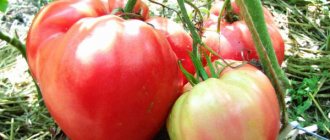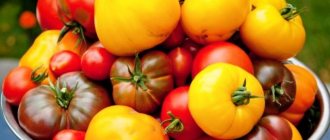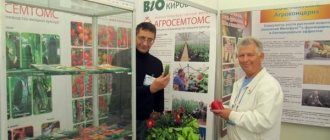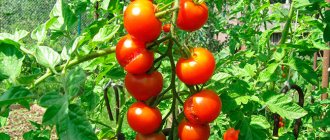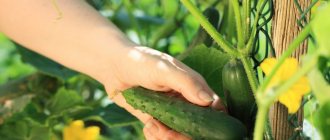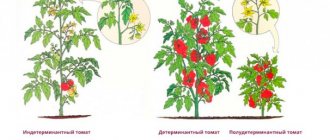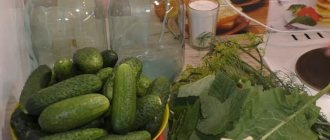Gardeners are increasingly planting tomato varieties on their plots. Most of these plants are intended for planting indoors. They were bred to be grown on a large scale for industrial purposes. But ordinary summer residents also loved them.
The distinctive quality of these tomatoes is that their fruits ripen almost simultaneously. They form a kind of bunch with many tomatoes and are very decorative.
Carpal varieties have a number of advantages:
- high productivity;
- good gastronomic qualities;
- ripened tomatoes do not rot or fall off;
- can be collected in bunches.
Seeds are planted for seedlings. Sowing time depends on climatic conditions.
Among the raceme tomatoes there are indeterminate (tall) and determinate (short) plants. Indeterminate bushes are formed leaving one main stem. Determinate - in several stems. Tall bushes need to be tied to a trellis or stakes.
The brush of such tomatoes can be simple, intermediate, complex or very complex. There are very few plants with a complex raceme. One bunch can consist of 30-100 tomatoes.
According to the ripening period, tomatoes can be:
- ultra early ripening 80-85 days;
- early ripening 90-95 days;
- mid-season 100-115 days;
- late ripening 120-130 days.
For areas with a temperate climate, early varieties are better suited. Late-ripening ones can be planted only in the south of Russia, or in greenhouses with additional heating.
Hybrids are considered the best cultivar tomatoes. These tomatoes require a lot of attention. They are high-yielding, the fruits are beautiful, smooth, with shiny skin, transportable, and not susceptible to diseases. In terms of taste, hybrids are not inferior to other varieties. Well kept.
Hybrids are obtained by crossing two species. They are designated by the letter F1 (first generation), obtained by crossing. Hybridization is complex, long manual labor. The seeds of such plants are more expensive.
The best hybrids
Instinct F1
The hybrid is undemanding to lighting and is classified as mid-season and tall. Weight can reach 110 g.
True friends F1
The variety is early ripening, plant height up to 2 m. Tomatoes up to 100 g, the number of tomatoes in one bunch is 7-12. One bush can produce up to 9 kg of harvest. Ripe tomatoes are red in color. The hybrid is suitable for growing in the northern regions of Russia and tolerates temperature changes well.
Carpal F1
It is undemanding to sunlight, gives a good harvest even in the north of Russia, tomatoes are filled up to 110 g.
Barberry F1
An early-ripening, indeterminate raceme tomato is considered small-fruited, since each fruit weighs within 25 g. One bunch can contain up to 50 pieces, the color is pink. Refers to cherry tomatoes.
Intuition F1
An early variety, ripe tomatoes can be obtained 110 days after sowing the seeds; they will weigh about 100 g and are red in color. The hybrid can be grown in cold climates.
Comet F1
The brush tomato has large fruits, a red color and a weight of about 80 g. It was bred by foreign breeders. Medium-sized, light-loving, bears fruit well in different natural conditions.
Red star F1
Large-fruited tomato, its weight is about 110 g. A variety with early ripening, bears fruit well.
<
Grozdevoy F1
Early ripening, indeterminate. One bunch contains 8-9 red tomatoes weighing 100 g. It is undemanding to watering and very portable.
Juggler F1
One bunch of this variety contains 5-6 tomatoes, is high-yielding and tolerates transportation well. Excellent storage.
Important! Seeds of hybrid raceme tomatoes cannot be prepared for sowing next year on their own. They can only be purchased in specialized stores.
Hybrids are the best, but we must not forget that when growing them, it is necessary to follow all the rules of agricultural technology. They bear fruit well only with proper care.
Advantages and disadvantages
For pink tomatoes, it is necessary to create certain agricultural conditions. In order for the harvest to be high and the fruits not to crack, you must adhere to the following rules:
- Pink varieties do not tolerate a lack of moisture, so you should always ensure that the soil is slightly moist. They need regular watering (at least 2 times a week) with warm and settled water. In this case, the liquid should not get on the leaves and stems.
- It is better to water early in the morning so that diseases do not develop and the tomatoes can better withstand the daytime heat.
- Due to sudden temperature changes, tomatoes can crack, so the contrast between night and day temperatures should be minimal.
- Pink tomatoes are more likely to suffer from late blight. Before planting seedlings, it is necessary to disinfect the soil with a solution of potassium permanganate. The De Barao variety is more resistant to late blight.
- Biological products (Glyokladin, Gamair) are used to prevent diseases.
- Bushes of large-fruited tomatoes must be tied to a support so that the stems do not break. It is best to organize a trellis 1.5 m high.
- Pink tomatoes are larger, so they need more nutrients to ripen.
- It is necessary to regularly carry out pinching and feeding of bushes, as well as loosen the soil.
Tomatoes for greenhouses
For planting under cover, the best tomatoes are the indeterminate type. These are tall plants; under favorable weather conditions they are unlimited in growth, so they need staking.
Semi-determinate species can be grown in a film greenhouse. These are plants that occupy an intermediate position between tall and short-growing tomatoes.
When choosing seeds, you need to pay attention to the form in which the tomatoes will be consumed. The best varieties for preservation are considered to be Cherry Cocktail and Patron. Cherry tomatoes are also good.
Purple candle
Early ripening, productive tomatoes are recommended to be grown indoors. The bush is low, the foliage is average. There are from 8 to 12 fruits on the brush. Form a plant into two stems.
The fruits are long with a “spout”, cylindrical in shape. In the mature stage, crimson in color, not prone to cracking. Pale pink tomatoes can be picked from the bush; they ripen well.
Up to 4 plants can be planted per 1 m2. If you follow the rules of agricultural technology, you can get 8.5–10 kg of fruit from 1 square meter.
Large-fruited
Large-fruited raceme-type tomatoes are hybrids; they bear fruit well even in a greenhouse without heating. The best large-fruited varieties for indoor ground are as follows.
Red red F1
Early ripening, one bunch contains up to 7 tomatoes, its weight reaches up to 500 g. The tomato is tall, one bush produces up to 8 kg.
Chelyabinsk meteorite F1
Low-growing, early ripening, orange-red in color, weighing about 300 g. Intended for fresh consumption.
Spasskaya Tower F1
A cluster variety with an average ripening period, semi-determinate. Weight 200-500 g, quantity per brush – 5-6 pcs. Color – red.
Martez F1
Tall, late-ripening hybrid variety with pink fruits. Weight 240-260 g, has good taste, intended for fresh consumption.
Maryina Roshcha F1
Early ripening, the weight of one cluster is up to 170 g, the number of fruits is up to 9. It tolerates transportation well over long distances.
Attention! Large-fruited raceme tomatoes are considered premium varieties.
Characteristics of tomato varieties
Biological and economic features of raceme tomatoes:
- Aligned fruits: the fruits on the cluster practically do not differ in size and shape.
- Simultaneous, friendly maturation. Fruits on a cluster reach their technical and biological ripeness almost simultaneously, due to the presence of genes in them that control ripening.
- They are distinguished by the strong attachment of the fruit to the stalk of the hand. In cluster form, the fruits are easily transported and stored for a long time without breaking off.
- Duration of storage. This is facilitated by the presence of a fairly large amount of pectin in the fruits.
- Resistant to cracking. Having a dense pulp structure and a dense peel, the fruits retain their integrity for a long time, without cracking even with a sharp change in temperature and humidity conditions.
- Delicious fruits, rich in ascorbic acid, the amount of which not only does not decrease with time, but even increases.
They are grown mainly in protected soil. Plants are almost always tall, indeterminate and require cultivation in a tied form. In open areas, there is a high probability of tomato bushes breaking under the weight of bunches of fruit, especially during periods with strong gusts of wind. In the northern regions, the short growing season does not allow waiting for the brushes to ripen completely in open ground.
| Note! When these varieties are grown in open ground, it is possible to reduce the duration and increase the speed of harvesting due to the rapidity of ripening. This is welcome in industrial cultivation. |
The point about greenhouse cultivation can also be considered a disadvantage, since not everyone has such an opportunity. And in the southern regions, open ground is a priority. Greenhouses are used mainly to obtain early production.
Photo pixabay/byrev: The fruits usually have good taste.
Medium-fruited
Their weight varies between 150-200 g. Hybrids are characterized by high productivity; they are obtained by crossing. The following varieties are considered the best medium-fruited varieties.
Natus F1
A low-growing red tomato with a tomato weight of up to 150 g.
Tomato Tretyakov F1
Indeterminate, raspberry color, fruit weight up to 150 g. Suitable for canning.
Forte orange F1
Tall, early-ripening variety, with a mass of ripened fruits up to 200 g.
Red Guard F1
Super determinate tomato. One bunch consists of 7-9 tomatoes, the weight of each varies between 150-250 g. The finished fruits are used fresh.
Sweet cherry F1
Ultra-early hybrid. The time from seed germination to fruit ripening is 80 days. A tall bush up to two meters requires tying. Form into two stems, the remaining shoots are removed.
The fruits are smooth, round in shape, bright red when fully ripe. They can be preserved whole or ready-made dishes can be decorated with these small tomatoes. The advantages of the variety include early ripening, long-term fruiting and high decorative appearance of the fruit. Seedlings are planted at the second leaf stage, and four specimens per square meter are placed in a permanent place.
Small-fruited
These varieties of grape tomatoes are consumed both fresh and for preservation. Small-fruited raceme tomatoes have a variety of varieties.
Weight does not exceed 100 g. Depending on the weight of the fruit, varieties are divided into:
- dessert up to 30 g;
- cherry up to 70 g;
- small-fruited up to 100 g.
They can have different colors:
- red;
- yellow;
- emerald;
- pink;
- orange;
- brown.
Let's look at the best small-fruited raceme tomatoes.
Black chocolate
Early ripening, tall, brown in color. The weight of one tomato is up to 25 g.
Monisto emerald
Indeterminate, with a fruit weight of up to 35 g. The harvest is consumed mainly fresh.
Bon Appetit
The harvest can be harvested 95 days after planting. Plants are grown in greenhouses. The variety is tall; one bunch grows up to 10 tomatoes weighing up to 100 g. The color is red, the taste is sweet.
Mandarin duck
It has good taste and is indeterminate. Tomatoes weigh up to 100 g.
Cio-Cio-San
Indeterminate, intended for planting in a greenhouse. Tomatoes weigh up to 60 g, one brush from 10 pcs. The shape is similar to a plum. Used both for canning and for fresh consumption.
Potted orange
Early ripening, low-growing tomato. Can grow in a pot, weight about 40 g.
Monisto chocolate
The fruits are brown, weigh up to 40 g, sweet, with an average ripening period. The variety is considered high-yielding, the bush is considered tall.
Orange caviar
An early-ripening and low-growing variety, used primarily for canning. Tomatoes weigh up to 20 g.
Cherry Negro F1
Tall hybrid, ripening period 95 days. Ripe dark tomatoes have a sweet taste and weigh up to 35 g.
Monisto pink
With an average ripening period, high-yielding and tall. The weight of ripe fruit reaches 40 g.
Ushakov
Low-growing, early-ripening tomato, with each tomato weighing up to 70 g.
Attention! Seeds of the above varieties (except for the hybrid Cherry Negro F1) can be prepared for sowing at home.
Red star f1
Early ripe tomatoes. This hybrid species has increased productivity. It has very large fruits for a raceme variety. Each can reach 110 g. The inner part is dense, has increased taste, and noticeable sugar content. Can be canned, processed and consumed raw.
It is resistant to infection by blossom end rot. Shows decent yield even with little care. It grows and bears fruit in many climatic zones, including the northern regions of Siberia.
Tomatoes for open ground
Most raceme tomatoes are designed for planting indoors. But, through the diligence of breeders, varieties have been created that can grow in open ground. However, they require a lot of attention: they are heat-loving, and without proper care it is impossible to get a good harvest.
Ivan Kupala
The tomatoes are red-raspberry in color, pear-shaped, and weigh up to 140 g. Can be consumed fresh and for preservation. With an average ripening period. Semi-determinant. It tolerates high air temperatures well and bears fruit well only with sufficient sunlight.
La la fa F1
The plant is of medium height, the ripening period is 115 days. Tolerates short-term drought and bears fruit well. Used for canning. The tomatoes are dark red, weighing about 120 g.
Banana red
Red fruits weigh up to 100 g, have an average ripening period, and are transportable.
Grape
Early ripening indeterminate variety. One brush can contain up to 30 tomatoes.
Roma
Low-growing, drought-resistant red tomatoes, weighing 80 g. With an average ripening period. Suitable for transportation over long distances and for long-term storage.
Attention! Carpal varieties for open ground are recommended to be planted in the southern regions.
The best varieties of pink tomatoes: top 25 most popular
Note! The list of the best pink tomatoes was prepared based on the degree of popularity of the names of varieties and hybrids, analysis of reviews from experienced gardeners, as well as the personal opinion of the author.
The most popular and best varieties of pink tomatoes can be called ( alphabetically ):
By the way! The most common pink varieties are the following (in order of popularity): Pink Honey, Batyanya and Velmozha
- three main hits. Next in popularity are Grandmother's Secret, Pink Elephant, Miracle of the Earth, Ox's Heart, Petrusha the Gardener, Abakan Pink, etc.
Abakan pink
- Early ripening variety.
- The plant is determinate, the bush is 1.1-1.7 m high. It is grown in 1-2 stems.
- For open and protected ground.
- The fruits are large, flat-round, slightly ribbed, pink in color. The number of nests is more than 6.
- Weight - up to 500 g (average 200 grams).
- Productivity - 4-5 kg per sq.m.
- The taste is good or excellent. Ideal for preparing salads.
Grandma's secret
- Mid-season variety. The ripening period is 115-125 days.
- The plant is indeterminate, 150-170 cm high. One cluster bears 3-6 fruits.
- For film shelters and greenhouses.
- The fruits are flat-round, red-crimson (pink) in color, with few seeds.
- Weight - 354 g (up to 1000 grams).
- Productivity - 16.9 kg per sq.m.
- Excellent taste: the fruits are sweet and fleshy. Perfect for fresh consumption and winter preparations.
Dad
- Early ripening variety. From germination to the beginning of ripening - 90 days.
- The plant is indeterminate, 1.7-2.0 m high.
- For cultivation in glass and film greenhouses or in open ground (in a stake culture).
- The fruits are heart-shaped with a spout, very smooth, shiny, crimson in color.
- Weight - 200-350 grams.
- Productivity - up to 17 kg per sq.m.
- Excellent taste: the fruits are sugary and sweet.
- Salad purpose: for fresh consumption.
- The fruiting period is very long.
- Cold resistant.
Bull heart pink
- Mid-season variety (110-115 days).
- The plant is determinate, 1.4-1.6 m high. Requires pinching. There are 3-4 fruits on the hand.
- For open ground (with a tie to stakes), film greenhouses and greenhouses.
- The fruits are flattened-cone-shaped (resembling the shape of a heart), raspberry-pink, smooth,
- Weight - 250-350 grams (individuals up to 400).
- Productivity - 7.5-8 kg per sq.m.
- The fruits are fleshy, juicy, high in sugar, and have excellent taste.
- Salad purpose: recommended for fresh consumption.
Nobleman
- Mid-season variety. It begins bearing fruit 103-117 days after germination.
- The plant is determinate, 50-60 cm high. The inflorescence is complex. The first inflorescence is laid above the 7-8 leaf, the subsequent ones - after 1-2 leaves.
- For open ground and temporary film shelters.
- The fruit is heart-shaped, medium-ribed, crimson. The number of nests is 4 or more.
- Weight - 130-250 grams.
- Productivity - 8 kg per sq.m.
- The fruits are of good or excellent taste, juicy, sugary. Salad purpose.
The second name of the variety is “Budenovka” .
Ox heart
- Mid-season variety (111-115 days).
- The plant is semi-determinate, up to 120 cm high (according to other sources, indeterminate, up to 160-180 cm). 4-5 clusters are formed on the main stem, each containing up to 5 large fruits.
- For open ground, film greenhouses and greenhouses.
- The fruits are multi-chambered, cone-shaped (heart-shaped), pink-crimson,
- Weight - 300-500 g (according to other sources, 150-300 grams).
- Productivity - 6-8 kg per sq.m.
- The taste is excellent: the fruits are fleshy, very juicy,
- exceptionally tasty and aromatic.
- For preparing fresh salads and juices.
- It has complex resistance to major tomato diseases.
De Barao pink
- Mid-season variety (115-120 days).
- The plant is indeterminate, medium-branched, medium-leaved, 2.5-2.7 m high. The first inflorescence is formed above the 9-11th leaf, the subsequent ones - after 3 leaves.
- For film greenhouses and open ground (in the southern regions with a garter to stakes).
- The fruit is oval, smooth, deep pink.
- Weight - 60-90 g.
- Productivity - 5.4-6.8 kg per sq.m.
- The fruit is dense, high in dry matter and sugars, and has good taste.
- Excellent for preparing fresh salads, recommended for whole-fruit canning and pickling.
- Resistant to late blight, cold-resistant, shade-tolerant.
- Excellent transportability and keeping quality of fruits.
- Long fruiting (until frost).
Demidov
- Mid-season variety. It begins to bear fruit 100-110 days after mass germination.
- The plant is determinate, standard, erect, weakly branched, medium-leaved, 60-65 cm high. The first inflorescence is formed above the 6-7 leaf, the subsequent ones - after 1-2 leaves.
- For growing in open ground. Suitable for Siberia.
- The fruits are round, bright pink, fleshy. The number of nests is more than 4.
- Weight - 80-120 g,
- Productivity in open ground is high - 4-5 kg per square meter. m.
- Taste is good to excellent, pleasant aroma.
- Intended for fresh consumption.
- The fruits set well during sudden temperature fluctuations and ripen well.
Note! If there is uneven moisture, the fruits crack; if there is a lack of moisture, they are affected by blossom end rot.
wild Rose
- Early ripening variety (110-115 days).
- The plant is indeterminate, 1.5-2 m high. Requires pinching and staking.
- For cultivation in open ground and film greenhouses.
- The fruit is large, round, pink in color. The number of nests is more than 4.
- Weight - 300-350 g (maximum up to 400 grams).
- Productivity - 6 kg per sq.m.
- The taste of fresh fruits is excellent.
- Resistant to tobacco mosaic virus. Heat-resistant, resistant to salinity.
Figs pink
- Mid-early variety.
- The plant is indeterminate, tall. Form into one stem, removing all the “stepchildren” and lower leaves, and also pinch off the growing point at the end of the growing season.
- For cultivation in greenhouses and open ground (southern regions, with a garter to stakes).
- The fruits are ribbed at the base, very large, fleshy, multi-chambered,
- Weight - up to 350-650 g.
- The pulp is juicy, tender, sugary, with a rich tomato taste. An excellent choice for preparing fresh summer salads, tomato juices and home canning.
- The assorted pickles made from three colors of the Fig variety (Red Fig, Pink Fig, Yellow Fig) look especially appetizing.
- The variety has complex resistance to tomato diseases.
Crimson Giant
- Early variety. From germination to the beginning of fruiting - 105-110 days.
- The plant is determinate, spreading, 70-90 cm high. Requires moderate pinching.
- For open ground and film shelters.
- The fruit is flat-round, crimson.
- Weight - 200-400 grams (the first ones - up to 500-600 g).
- Productivity - 5.9 kg per sq.m.
- Excellent taste and valuable dietary qualities.
- Salad purpose: recommended for fresh consumption and preparation of various salads.
Honey
- Mid-season variety (110-115 days).
- The plant is indeterminate, up to 1.5 meters high, requires staking and shaping.
- For growing in open ground and under film covers.
- The fruits are very large, flat-round, smooth. The color of the ripe fruit is crimson. The number of nests is more than 6.
- Weight - 300-400 grams.
- Productivity - 7-8 kg per sq.m.
- The taste is excellent, very juicy and sweet. Ideal for preparing salads and juices, light cooking is possible.
Mikado pink
- Early ripening variety (94-95 days from germination to fruiting).
- For film and glazed greenhouses.
- The plant is indeterminate (with unlimited growth), 1.5-1.8 m high. Plants must be staked a few days after planting. The plant is formed into one stem, removing all the “stepchildren” and lower leaves, and also pinch the growth point at the end of the growing season, above the 7-8 brush, leaving 2 leaves above the last brush.
- The fruits are flat-round or round, pink, smooth, even in shape and size, quite dense, fleshy.
- Weight - 300-400 g (individuals - up to 600 g).
- Productivity - 5-6 kg per sq.m.
- The pulp has a delicious taste, juicy, sweet, with a high content of carotene, lycopene and selenium.
- The fruits are perfect for making salads and canning in pieces.
- Resistant to major tomato diseases.
Eagle beak
- Mid-season variety.
- The plant is indeterminate, medium-sized, depending on growing conditions, with a height of 1.2 to 1.5 m, requires staking and moderate pinching. The first inflorescence is laid above the 10th leaf, the subsequent ones - after 3 leaves.
- Recommended for growing in open and protected ground.
- The fruits are raspberry-pink in color and resemble the powerful curved beak of an eagle.
- Weight - 200-400 g (the first ones up to 800 grams).
- Productivity - up to 6-8 kg per plant (or 10.5-14.4 kg per sq.m.).
- The pulp is low-seeded and very dense, which ensures good keeping quality and high pickling qualities of the fruit.
Petrusha - gardener
- Medium early variety.
- The plant is determinate, standard, low-growing, 50-60 cm high. It practically does not require pinching.
- Recommended for growing in open ground and film shelters.
- The fruit is oval-elongated (cylindrical with a pointed apex), smooth, medium density, crimson (pink). The number of nests is 6 or more.
- Weight - up to 200 g (average 150-180 g).
- Productivity - 4-6 kg per sq.m.
- The fruits are fleshy, sugary, very tasty both fresh and canned.
Pink Bush F1
- Early ripening hybrid.
- The plant is determinate, low-growing, with short internodes.
- For cultivation in open ground and under temporary film covers.
- The fruits are large, rich pink in color, and quite dense. The number of nests is 4-6.
- Weight - 180-210 g.
- Productivity - 2.5-5 kg per sq.m.
- The pulp is juicy, with a sugary taste. Recommended for preparing salads, appetizers and slicing.
- The hybrid is resistant to a complex of diseases: nematode, verticillium, fusarium and cladosporiosis. Transportable.
Pink Paradise F1
- Mid-season hybrid.
- The plant is indeterminate (with unlimited growth), tall, powerful, well leafy. It is necessary to tie up the plants a few days after planting. Form into one stem, removing all the “stepchildren” and lower leaves, and also pinch off the growing point at the end of the growing season.
- For cultivation in film greenhouses.
- The fruits are flat-round, fleshy, pink. The number of nests is 4 or more.
- Weight - up to 200 g.
- Productivity - up to 4 kg per square meter.
- The pulp is juicy, delicious, and quite dense.
- Recommended for preparing salads.
- Resistant to a number of tomato diseases (verticillium wilt, fusarium wilt, TMV).
Pink heart
- Mid-season variety, begins to bear fruit 110-115 days after germination.
- The plant is indeterminate (about 2 meters), compact in structure.
- For film greenhouses.
- The fruits are heart-shaped, slightly ribbed, raspberry-pink, with a small number of seeds.
- Weight - 200-230 g (the first ones up to 400 grams).
- Productivity - 6-7 kg per sq.m.
- The fruits are tasty and aromatic. For fresh consumption and juice production.
- Resistant to TMV, cladosporiosis, Alternaria leaf spot, fruit cracking.
Pink giant
- Mid-season variety, from germination to ripening 111-115 days (according to other sources, 120-125 days).
- The plant is indeterminate, 2.0 m high. After planting in a greenhouse, it is formed into 1-2 stems. The first inflorescence is laid above the 9th leaf, the subsequent ones - after 3 leaves.
- For film shelters and glazed greenhouses.
- The fruits are flat-round, intense raspberry-pink in color. The number of nests is more than 4.
- Weight - 200-300 g (maximum up to 700 grams).
- Productivity up to 2.5-3 kg per square meter. meters (according to other sources, 5.8-6.4 kg per square meter).
- The fruits are very tasty and fleshy.
- Recommended for fresh consumption.
- Moderately resistant to major tomato diseases.
Pink honey
- Mid-season variety. From germination to fruiting - 100-120 days (on average - after 115 days).
- The plant is determinate, low-growing, 60-70 cm high, with a high load of heavy fruits. It should be grown in 2-3 stems with a garter.
- For open ground and film shelters.
- The fruits are truncated heart-shaped, deep pink in color with a moiré tint.
- Weight - from 400 to 1500 grams.
- Productivity - more than 6 kg per bush.
- The taste is excellent. For fresh consumption, home cooking and market sales.
Pink Elephant
- Mid-early variety (the period from full germination to fruit ripening is 110-115 days).
- The plant is semi-determinate, medium-sized, medium-leafed. The first inflorescence is laid above the 7th leaf, the subsequent ones - after 2-3 leaves.
- For growing in open ground and under film covers.
- The fruit is large, ribbed at the base, fleshy, multi-chambered. The color of the ripe fruit is pink.
- Weight - 300 g (maximum up to 800 grams).
- Productivity - 6.5-8.5 kg per sq.m.
- The taste is excellent. Recommended for fresh consumption, in salads.
Pink flamingo
- Mid-season variety. The period from germination to the beginning of ripening is 110-115 days.
- The plant is determinate, up to 60 cm high.
- For open ground and film greenhouses.
- The fruit is round, slightly ribbed, medium density, pink in color. The number of nests is 4-6.
- Weight 95-110 g.
- Productivity - up to 3.5 kg per sq.m.
- Excellent taste, universal use: for salad and tomato juice.
- It is highly resistant to diseases.
Sugar bison
- Mid-season variety, from germination to fruiting in about 110 days.
- The plant is indeterminate, tall (up to 1.8 m). Lay the first inflorescence above 6-7 leaves, subsequent ones - after 1-2 leaves.
- The fruits are heart-shaped, dense, multi-chambered, raspberry-pink in color.
- Weight - 200-250 g (the first ones up to 350-500 grams).
- Productivity - 6.5-7.2 kg per sq.m.
- The fruits are fleshy, sugary, of excellent taste. Great for salad.
Super-klusha
- Mid-early variety. From germination to fruiting - 100-105 days.
- The bush is standard, stable, low-growing, up to 30-40 cm high, does not require pinching (shaping).
- For open ground.
- The fruits are pink, round.
- Weight - 150-250 g.
- Productivity - up to 10 kg per sq.m.
- The fruits are universally used, tasty both fresh and canned.
- The harvest is hidden under the leaves deep in the bush.
Cio-chio-san
- Mid-season variety (110-120 days from germination to fruiting).
- The plant is indeterminate (with unlimited growth), medium-sized, medium-branched, medium-leafed. The first inflorescence is laid above the 9th leaf, the subsequent ones - after 3 leaves. A huge branched cluster produces 50 or more fruits.
- For film greenhouses and open ground with a garter to stakes.
- The fruits are plum-shaped (egg-shaped), pink.
- Weight - 30-40 g.
- Productivity - 4.0 kg per plant (or 7.8 kg m2).
- The fruits have an excellent dessert taste.
- Recommended for preparing salads and canning whole fruits.
- Resistant to tobacco mosaic virus.
Wonder of the Earth
- Mid-early variety. Fruiting begins 100-110 days after germination.
- The plant is indeterminate, sparsely leafed, up to 200 cm high.
- For cultivation in open ground and film shelters (greenhouses).
- The fruits are flat-round, deep pink (raspberry) in color.
- Weight - up to 1000-1200 g (average 380-700 grams).
- Productivity - 13.9 kg/sq.m (under film covers).
- The pulp has excellent taste, with a sweetish dessert taste.
- Universal purpose: for fresh consumption and processing into purees, juices and pastes.
- Tolerant to unfavorable growing conditions.
Monomakh's hat
- Mid-season variety.
- The plant is determinate, medium-sized, 90-130 cm high.
- For cultivation in open ground and film shelters (greenhouses).
- The fruits are oval-round in shape, dark crimson in color. Number of nests 4 or more.
- Weight - 600-900 g or more.
- Productivity - up to 20 kg per sq.m. in a greenhouse and up to 8 kg in open ground.
- The fruits are sugary and have very high taste. Used fresh and for canning.
- Quite highly resistant to major tomato diseases.
- Tolerates temperature fluctuations well.
- When the soil is waterlogged, the fruits are prone to cracking.
Japanese crab
- Mid-season variety (110-115 days).
- The plant is indeterminate, up to 2 meters high.
- For growing in open ground and under film covers.
- The fruit is flat-round, medium-ribbed, pink, multi-chambered.
- Weight - 250-350 g (the first ones up to 800 grams).
- Productivity - up to 11-15 kg per square meter.
- The pulp is fleshy, very tasty, juicy.
- Ideal for fresh consumption, in salads.
- It is distinguished by high yield and complex resistance to diseases (to crown and root rot, TMV).
Other varieties of pink tomatoes
It is not surprising that there is a huge number, albeit relatively less known, but quite reliable and proven varieties of pink (raspberry) tomatoes, among which the following can be distinguished (in alphabetical order):
- Altai pink;
- Scarlet candles;
- Anna;
- Banana pink;
- Dimensionless;
- Biysk rose;
- Brandy pink;
- Bugay pink;
- Your Honor;
- Victoria;
- Cherry pink;
- Pink pear;
- De Barao Tsarsky;
- Raspberry Rhapsody;
- Raspberry Viscount;
- Raspberry elephant;
- Mammoth;
- Millionaire;
- Pink Brandy;
- Pink Unicum;
- Early love;
- Rosamarin pound;
- Rosemary F1;
- Pink Lyana;
- Pink Tsar;
- Pink early ripening;
- Tsunami;
- Cherry Pinky;
- Japanese rose.
Due to the amazing number of advantages, pink (raspberry) varieties of tomatoes belong to the category of vegetables experiencing ever-growing consumer interest. Now you have the opportunity to correctly choose the variety that is best suited for the conditions of your site and, undoubtedly, will reward you with a generous harvest.
Video: the best varieties of pink tomatoes
New varieties 2016-2017
Breeders develop new varieties every year. Changing weather conditions and various diseases force the creation of plants with new characteristics.
Casper
An early ripening miniature bush with high productivity. The fruits are elongated, weighing up to 100 g.
Brother
Early ripening bush of small size. Can be planted in greenhouses. Small-fruited - up to 70 g. The fruits have a round shape and are consumed fresh. The tomato is decorative.
Novosibirsk pink
The bushes produce small-fruited tomatoes weighing up to 110 g and have a cubic shape. High-yielding, suitable for planting in open ground.
Kinder F1
Low-growing variety with early ripening. The harvest is harvested with tassels. 18-20 tomatoes weighing up to 35 g ripen in one bunch.
Creme brulee
Medium height plant. The tomatoes are dark, large, weighing up to 250 g each. The variety is intended for planting in a greenhouse or greenhouse. The fruits have a sour taste.
Okay
The bushes grow up to 130 cm in height, the ripening period is average. The weight of ripened fruits is up to 190 g, they are pear-shaped, used for canning or eaten fresh.
Blueberry and cream F1
The bushes are tall. Tomatoes are purple in color and weigh up to 20 g. They taste sweet.
Kira F1
Tall, intended for growing in greenhouses. Tomatoes have an elliptical shape, weighing up to 30 g.
Pepper
Designed for planting in closed or open ground. The height of the bush can be up to 1 m. The variety is small-fruited, high-yielding, with a weight of up to 80 g. The fruits are shaped like peppers.
Specific characteristic
Previously, gardeners also grew so-called cluster tomatoes. But the fruits on them did not ripen at the same time, and also, their size was not the same. After breeders began transforming such varieties, it became possible to pick ripe, juicy fruits at the same time, along with a dense brush that securely holds the tomatoes even during transportation.
The varieties of grape tomatoes cultivated today can be described as follows:
- Tomatoes on a bunch ripen almost simultaneously. After the lowermost fruits ripen, the upper ones still retain their presentation and do not lose their taste. A ripe brush can remain on the bush for about a month without reaching the stage of overripeness.
- The tomatoes are tightly attached to the branch. They can be collected together with a brush, and even light shaking and transportation over fairly long distances does not cause damage to the stalk. You can be sure that all the tomatoes will remain on the bunch.
- Tomatoes are the same size on the same bunch. If their size were different, the overall appearance would suffer, which affects their cost.
- Resistance to creases allows you to be sure during fruit filling that the clusters will be intact and the fruits will ripen successfully in the garden.
- Carpal varieties of tomatoes are distinguished by their ability to reliably resist cracking of fruits, despite unsuitable weather conditions or insufficient care for them.
In addition, the hybrids created by breeders are characterized by increased productivity, resistance to many types of diseases and pests of tomatoes, as well as early ripening. Another positive feature of such vegetables is that they do not require frequent fruit picking.
Advantages of greenhouse tomato cultivation
Typically, raceme tomatoes are grown in a greenhouse; only some varieties can be grown in the ground, and even those only in the south. Of course, growing tomatoes in greenhouses has a number of disadvantages, but there are also advantages:
- It is easier to fight diseases and pests in a greenhouse; drugs act more effectively in closed ground conditions;
- You can exercise full control over the growing conditions. In a greenhouse we are less dependent on weather conditions;
- Good greenhouses usually allow for two crops;
- Tall indeterminate tomatoes are best grown in greenhouses - it is easier to tie them up there, and there is no danger that strong winds or an animal will break the fragile stem.
This is especially important for the northern regions, where even early-ripening, low-growing tomatoes do not always have time to ripen in open ground.
Planting and growing
Planting of raceme tomatoes for greenhouses should be early. The seeds must be spread over the surface of the soil, which must first be moistened. This is very important, because drying out of the soil leads to the death of the plant. Next, everything needs to be sprinkled with sand and covered with film to maintain optimal humidity. During the growth of tomatoes, it is important to provide them with the desired temperature regime, minimizing temperature fluctuations day and night.
To grow brush tomatoes, it is important to follow the correct planting and watering algorithm. The first shoots usually appear after five to seven days. Then you will need to remove the film. It is important to constantly maintain soil moisture. After another seven days, the seedling should have its first leaf, after which it will be necessary to plant the seedlings into cups.
Planting in the ground should be done in warm weather to avoid hypothermia. The lowest temperature should not be below ten degrees. It is important to constantly monitor this. But low temperatures are not as dangerous for raceme tomatoes as their sudden and large changes.
Watering and fertilizing
20 days after planting, it will be necessary to apply the first fertilizer. It is necessary to choose complex compositions. Today there is a fairly wide range of high-quality fertilizers for growing tomatoes on sale.
When preparing the soil in a greenhouse, it is important not to overdo it with fertilizers, especially nitrogen-containing ones. This can affect the rapid growth of greenery, to the detriment of the appearance of fruits.
Watering tomatoes should be timely and moderate. Under no circumstances should the soil be allowed to dry out. Feeding should be done at least 4 times a season. It is worth giving preference to fertilizing containing potassium. This is very important, because cluster tomatoes need properly selected fertilizer.
In addition to frequent watering, the soil must be well loosened. This should be done as often as possible. The soil must always be loose. This ensures the necessary humidity. In addition, the soil can be sprinkled with sawdust, this will prevent the soil from drying out. The greenhouse must be ventilated after watering. This will prevent the appearance of fungus that destroys the plant.
Tomatoberry strawberry F1
Tall, mid-season variety. The brush is original, all hung with tomatoes in the shape of strawberries. The fruits are small, juicy and very sweet, weighing up to 30 grams. Like all hybrids, the variety is resistant to late blight and other diseases.
According to reviews, the tomato of this species retains its varietal characteristics when seeds are replanted from fruits of full maturity. This rare property is not at all characteristic of hybrid varieties of any plant.
Anniversary Tarasenko
I bought the seeds of these tomatoes for 20 rubles. From them I grew bushes 2 meters high. Each cluster contained about 25 fruits of varying weights. The heaviest weighed 300 grams, and the lightest - 80. The color of the fruit is red, rich. Tomatoes have a neat shape and thick skin. Small fruits are ideal for canning, while large ones are best eaten fresh. Among other things, tomatoes of this variety ripen well after harvest.
Pest and disease control
Like all crops, brush tomatoes are susceptible to various diseases and pests. One of the main and dangerous fungal diseases for tomatoes is late blight. Features of the plant damage are brown spots on the leaves. The disease is dangerous because it spreads very quickly and completely destroys the plant.
To avoid diseases such as cladosporiosis, fusarium wilt, and blossom end or root rot, you should choose first-generation hybrids for planting in a greenhouse. But regardless of the chosen variety of tomatoes, fertilizing and fertilizing are mandatory conditions. So, the basic rules that must be followed when growing truss tomatoes:
- abundant and frequent watering;
- regular ventilation of greenhouses;
- frequent loosening of the soil;
- timely feeding.
Growing the best grape tomatoes is not difficult in the climate of our country. It is important to just follow simple recommendations. Today there are quite a few varieties of this crop. Each type has its own characteristics and strengths. Therefore, before planting, you should familiarize yourself with all the benefits of the plant, its features and tips for growing it. Tasty and beautiful tomatoes are the result of the work of a gardener who does everything right.

